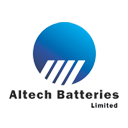Altech Chemicals (ATC) - Technical Analysis and Due Diligence
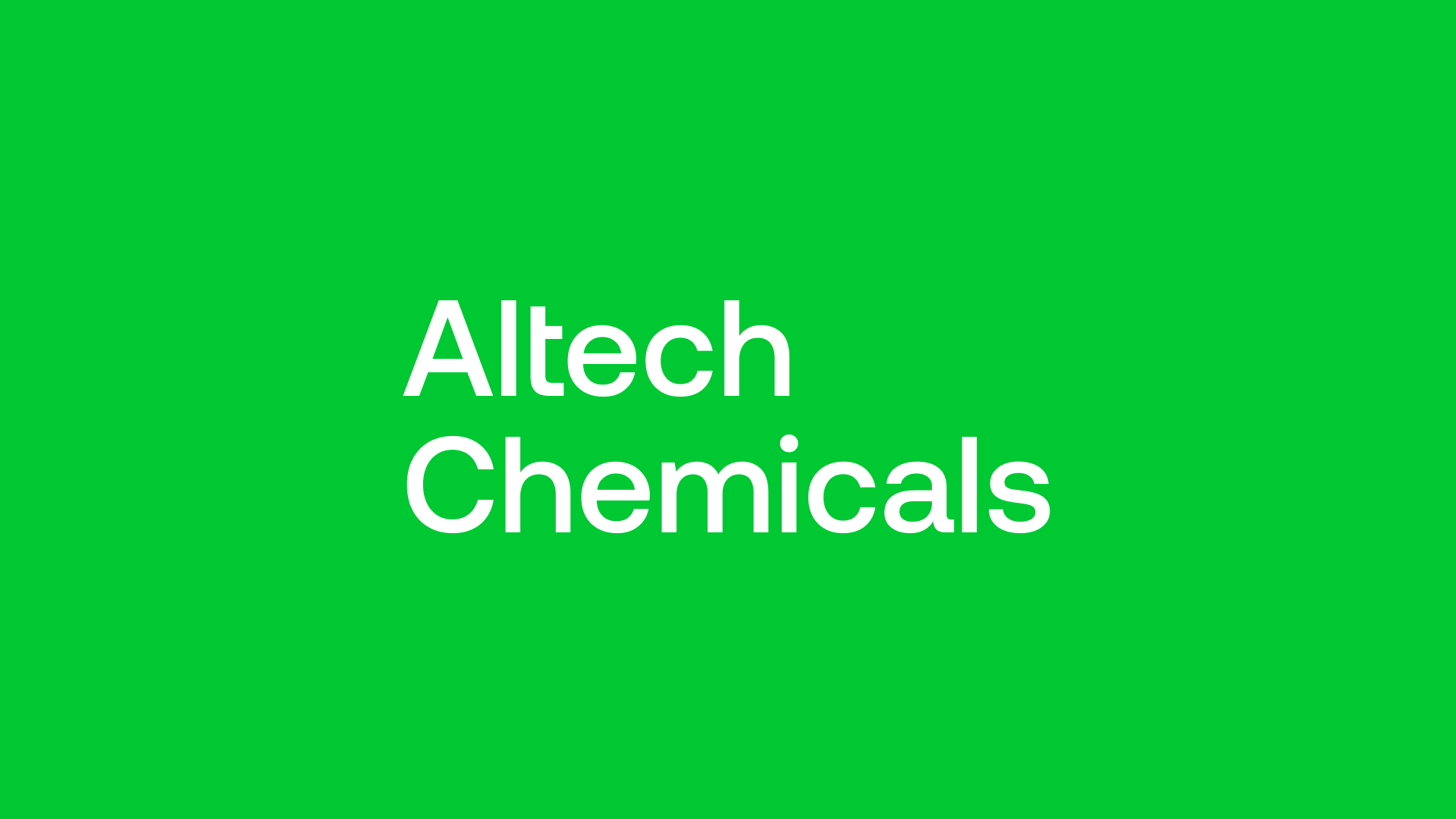
Merlin Marr-Johnson sat down with Iggy Tan, Managing Director of Altech Chemicals (ASX: ATC) to discuss the technical aspects of the company.
Altech Chemicals Limited is at the cutting edge of developing battery materials for the lithium-ion battery future and is successfully incorporating silicon in graphite anodes to produce higher energy density batteries. Altech Chemicals is a specialty battery materials technology company that is developing a 10,000t per annum silicon graphite anode plant in the state of Saxony, Germany using its proprietary high purity alumina coating technology. The company is positioning itself to supply battery material products to the burgeoning European electric vehicle market.
Merlin-Marr Johnson caught up with Iggy Tan, Managing Director, Altech Chemicals. Mr. Tan is a highly experienced mining and chemical executive with a number of significant achievements in commercial mining projects such as capital raises, funding, construction, start-ups, and operations. He has over 3 decades of chemical and mining experience and has served as an Executive Director for a number of ASX-listed companies.
Mr. Tan previously held the positions of Managing Director at Nickelore Limited, Galaxy Resources Limited, and Kogi Iron Limited. At Galaxy Resources, he was responsible for capital raises, construction, and start-up of the company’s Mt. Cattlin spodumene mine ($80M) and the Jiangsu Lithium Carbonate Plant ($100M), which resulted in the company becoming the world’s leading producer of high-purity lithium carbonate. The Jiangsu plant was eventually sold for $260M in 2014. His educational credentials include an MBA from the University of Southern Cross and a Bachelor’s degree in Science from the University of Western Australia. He is a Graduate of the Australian Institute of Company Directors.
Company Overview
Altech Chemicals Limited is aiming to become one of the world’s leading suppliers of 99.99% (4N) high purity alumina (HPA) (Al₂O₃). HPA is a high-value, high-margin, and high-demand product as it is the critical ingredient required for the production of synthetic sapphire. Synthetic sapphire is used in the manufacture of substrates for LED lights, semiconductor wafers used in the electronics industry, and scratch-resistant sapphire glass used for wristwatch faces, optical windows, and smartphone components.
There is no substitute for HPA in the manufacture of synthetic sapphire. The company was founded in 2007 and is headquartered in Australia. It is listed on the Australian Stock Exchange (ASX: ATC) and the Frankfurt Stock Exchange (FRA: A3Y). Altech Industries Germany GmbH, Musselbrook Iron Pty Ltd, Australia Mineral Sands Pty Ltd, Yilgarn Iron Pty Ltd, Kaolin Resources Pty Ltd, Canning Coal Pty Ltd, and East Pilbara Pty Ltd, are the company’s subsidiaries.
Altech Chemicals is using game-changing technology to advance silicon graphite anode material in Europe. The company is majorly focused on silicon in lithium-ion batteries. Notably, the development of lithium-ion batteries is focused on cathode material for many decades. The company is looking to focus on the anode or graphite side in order to increase the overall density of lithium-ion batteries.
In 2020, Tesla made a Battery Day announcement that it is looking to incorporate silicon into lithium-ion batteries. Interestingly, silicon has 10 times the energy density of graphite. The reason silicon isn’t being incorporated into commercial batteries is due to 2 major reasons.
The first one is that silicon expands 300% in volume during the lithiation process, where it gets to the point of fracturing. The lithiation process occurs when a battery goes through the first charge. At this time, the silicon expands and fractures to a point where it causes delamination in the battery, leading to swelling.
The second problem with incorporating silicon in lithium-ion batteries is that silicon has a first cycle loss of nearly 50%. The material grabs 50% of the lithium, making it inactive to the battery, and forms an SEI (Solid Electrolyte Interphase) layer. These 2 barriers stop silicon from being incorporated into commercial batteries.
Altech Company announced last year that it has overcome these challenges by cracking the silicon code. The company has successfully produced batteries that are 30% higher in energy density with the inclusion of silicon. The company is using a high-purity alumina layer to coat the silicon and graphite particles. This stops the particles from expanding and resolves the first-cycle loss problem.
Notably, the high-purity alumina coating contains the fracture. It inhibits the absorption of lithium, which is lost in the first change cycle. The company has run the batteries for very long cycles and has tested their stability. In fact, the company’s labs are now working on batteries that are pushing beyond the 30% energy density gain. It is now moving to the commercial stage. The company is working on building a proposed plant in Saxony, Germany.
It is important to note that Altech Chemicals has been working on solving this problem for the past 12-18 months. Several other companies have been working on the same. One of the solutions is to use nano-sized silicon particles, however, these are very expensive and hard to commercialise and scale-up. Altech Chemicals has a different solution that does not require nanoparticles. This allows the company to significantly bring down the cost of production.
The alumina coating used by the company has a 2-nanometer layer which prevents the lithium from passing through while maintaining battery performance. There has been extensive research conducted around alumina coatings. The company built on the existing research and used its own technology in order to develop a much cheaper process that is easy to scale up.
The Silumina Anode Plant
Altech Chemical is currently working on the commercial advancement of its plant. It is also working on a Pre-Feasibility Study (PFS). The company is now focused on making this project work on a commercial scale. It is looking to build a 10,000t per annum silicon graphite plant, that will produce silumina anodes. In essence, the company is buying graphite and silicon, and treating them with its in-house alumina coating technology, leading to silumina anodes as an end product.
The company recently announced the economics for the Silumina Anode plant. The capital cost for this operation is estimated at $95M, along with an NPV (Net Present Value) of $507M. The IRR (Internal Rate of Return) for the Silumina Anode Project is 40%. It generates around $63M EBITDA (earnings before taxes, depreciation, and amortisation), with a 3-year payback duration. The project has very attractive economics as a result of lower capital costs. The board has decided to move the project into a DFS (Definitive Feasibility Study).
In order to develop the commercial application for the project, the company is looking to produce commercial samples that can be sent to the end customers. The customers will then run the product through the extensive qualification process. In order to achieve this goal, the company is looking to build a pilot plant. It has already purchased a property in Germany for the plant. The company has also leased a large warehouse space next door. It is currently in the process of designing a pilot plant and building the plant for commercial samples.
The company is looking to complete the pilot plant by the end of 2022. Following this, it plans to commission an optimised process in order to get some of the samples to the downstream customers. The company’s project has generated a lot of interest, and it has successfully signed up NDAs with 2 German automakers and 1 NDA with a European battery maker. There has been a lot of interest in higher energy density batteries. This is because a higher energy density battery can help reduce the battery costs by scaling down the weight. This can potentially serve as the next phase of lithium-ion battery development.
A graphite anode runs about 330mAh (milliamp hour) current per gram. The company found that adding 10% silicon to the graphite doubles the current to around 600mAh-700mAh per gram. Adding 20% silicon leads to the tripling of the energy density, demonstrating the massive potential of silicon in batteries.
Altech Chemicals is aiming at a battery with +30% silicon. It is currently working towards developing the commercial side of the operation. The company has partnered with European suppliers due to the ongoing Ukraine crisis and supply chain issues. The company is looking to source all the materials for the European battery industry from within the continent. The company is sourcing graphite from SGL Carbon, a very large European graphite producer, and it is sourcing silicon from Ferroglobe, one of the largest European silicon producers.
Altech Chemicals has been successful in growing the current from 300mAh to 430mAh in its batteries. It has achieved a 30% increase in battery energy density. The company has found that lithium-ion batteries are very stable at this energy density. Its plant has the capacity to adjust the amount of silicon material in the graphite. This flexibility enables the company to increase the silicon content in the battery.
One of the major challenges in developing a silicon-based lithium-ion battery is to ensure stability over the battery’s life cycle. The company has run the 430mAh battery for 400-600 cycles and has tested its overall stability. The company’s scientists are adjusting the formulations in order to ensure battery stability.
Market Landscape
Altech Chemicals is in a unique position where there isn’t a market for silica-based lithium-ion batteries. Its batteries will be the first of their kind to enter the market. The company is looking to enter the market at the earliest in order to avoid imitators and competition. It is looking to establish the end customer base and operation at the earliest in order to be the first entrant in the market.
Shareholder Base
Altech Chemicals has 4 major institutional groups as shareholders, namely Deutsche Balaton, MAA Group Berhad, Delphi Group, and SMS Group. These groups constitute 30% of the company’s shareholder register. 3 of these groups are German institutions, while the fourth one is a Malaysian group headed by a prince. The prince is a member of the Board and a long-time company shareholder. The remaining 70% comprises retail investors.
The company currently has the financial capacity to fund the pilot plant and the DFS. It is in conversation with several institutions and is looking to grow its institutional shareholder base. Retail investors are also important for the company as they help create liquidity. The company has a highly liquid stock, it recently traded nearly 40M shares in a single day. The high turnover and high liquidity is preferred by institutions as well. The company has a massive base of about 6,500 shareholders.
Milestones
One of Altech Chemical’s major milestones was to get the Pre-Feasibility Study done and advance the pilot plant. The company anticipates that its project will generate a lot of interest as it is a green project. Interestingly, its Saxony project has been accredited by Cicero, one of the largest accreditation groups in the world, based in Norway. The company’s project has been given a green status.
The company is using renewable electricity in its operations. By increasing the energy density of batteries, the company is reducing per energy unit of carbon dioxide or greenhouse gases, which in essence reduces the carbon dioxide footprint of lithium-ion batteries. Due to these factors, the company’s operation is accredited as a completely green process. It expects to attract a lot of institutions through green accreditation. As per the company, there is a lot of capital that can be deployed towards green projects, helping reduce the impact of climate change.
The European EV Market
Altech Chemical anticipates that Europe will be the story of the lithium-ion battery industry in the coming decades, driven by carbon dioxide regulations by the EU (European Union). The regulations have led all the European automakers to make announcements that they plan to phase out all gas-powered vehicles and focus solely on producing electric vehicles by 2030 and 2035.
A 600-gigawatts battery production capacity has been announced for Europe. Notably, Tesla opened up its Gigafactory in Berlin, which is located close to the company’s project site. There has been a lot of focus around Europe on EVs (Electric Vehicles) and the battery side. The EU has a strong focus on self-sufficiency, and as a result, it is not looking to rely on materials or batteries sourced from outside Europe.
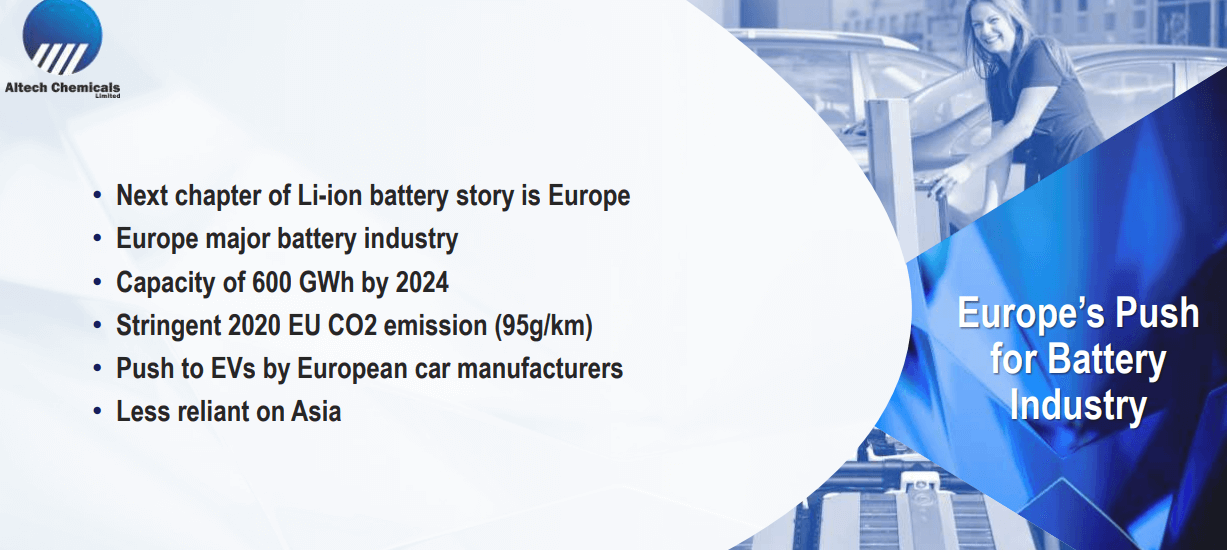
The Malaysian High Purity Alumina Plant
Altech Chemicals is looking to become the world’s leading supplier of 99.99% (4N) high-purity alumina (Al₂O₃) through the construction and operation of a proposed 4,500t per annum high-purity alumina (HPA) processing plant at Johor, Malaysia. Feedstock for the plant will be sourced from the company’s 100%-owned Kaolin deposit at Meckering, Western Australia
Altech Chemicals is looking to secure an alumina feedstock that isn’t centred around the Johor project. This is because, in the first phase of the project, the company isn’t looking to be tied to the Johor project’s timeframe. The project is currently in the financing stage. The company is looking to source its own alumina, purify it, and use it in a coating separate from the Johor project. This will enable the company to decouple both projects.
The company is focusing on the financing of the HPA (High Purity Alumina Plant) project in Johor. This serves as an additional opportunity to take the alumina downstream, bringing it closer to the lithium-ion battery end-user. The company is sourcing its alumina hydroxide feedstock from a European supplier. The material needs to be purified in order to be used in the coating process. The company is looking to build a silumina anode plant in Saxony, Germany. This plant will purify the alumina and work on a material application for the new mix.
The Johor project is currently in the funding stage. The company is looking to go through the green bond process where it has access to $144M of secondary debt. The company also has a partner that is focused on the equity part, which is running alongside the project. The company is putting in extensive effort and resources in order to commercialise the project. The company’s partner is a US banking group called Belmorgan. The group is looking for equity partners for the Johor project as well.
The Johor Project produces high-purity alumina. In the long-term, the company is looking to use the high-purity alumina and go downstream in order to use it in silumina anode plants around Europe. The first stage of the project is a 10,000t plant. This would be a small plant considering that Europe would need around 600,000t graphite in the EV industry alone. The metrics demonstrate the market’s demand forecast.
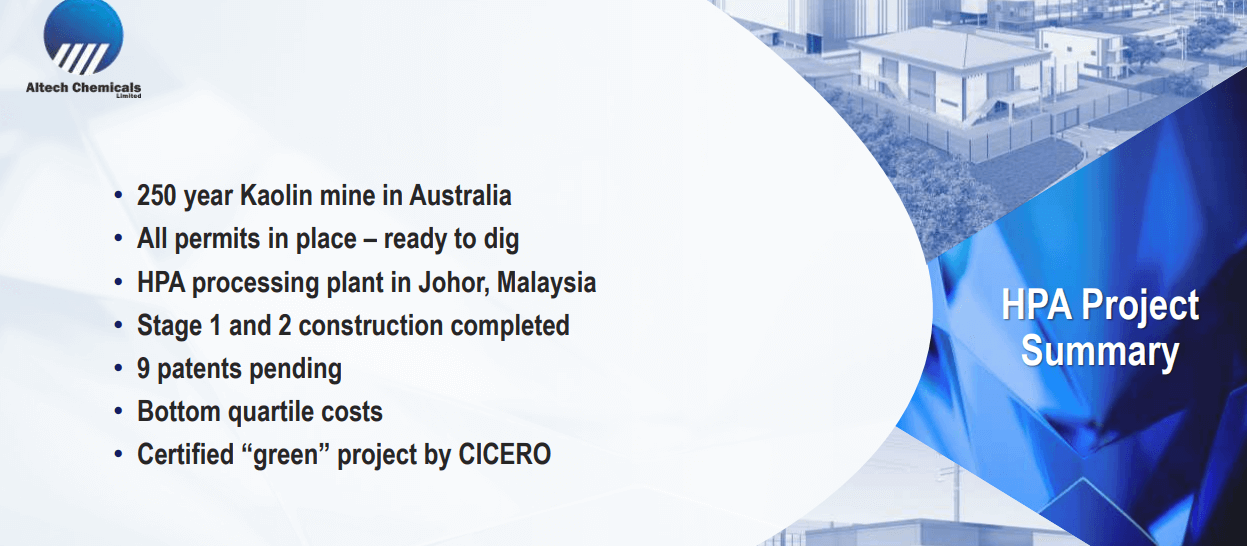
As per the company, 600 gigawatts of battery capacity would require around 600,000t of graphite. It is looking to provide graphite with silicon material as a premium anode for batteries. The company is incorporating silicon and alumina in order to create a higher performance anode that can improve the energy density and range of batteries while at the same time, increasing the mine life.
Altech Chemicals is looking to decouple the 2 projects because the HPA project has a significantly larger production capacity. However, it requires its own funding. The company is looking to use the HPA from the Johor project for other applications such as LED substrates, other parts of lithium-ion batteries, and more. The material has a lot of demand outside the lithium battery industry as well. Over time, the company is looking to take some of the HPA supply and allocate it to the European anode market.
Alumina is commonly produced using bauxite. However, bauxite cannot be used to produce high-purity alumina because the process makes use of sodium hydroxide. During this process, the sodium gets caught in the crystal structure and is very difficult to remove. As a result, the production of high-purity alumina requires a different process and feedstock. It utilises kaolin and hydrochloric acid to develop high-purity alumina. The kaolin is calcined by heating up to 700 degrees and then leached into the hydrochloric acid. The solution is then purified and calcinated back to the alumina.
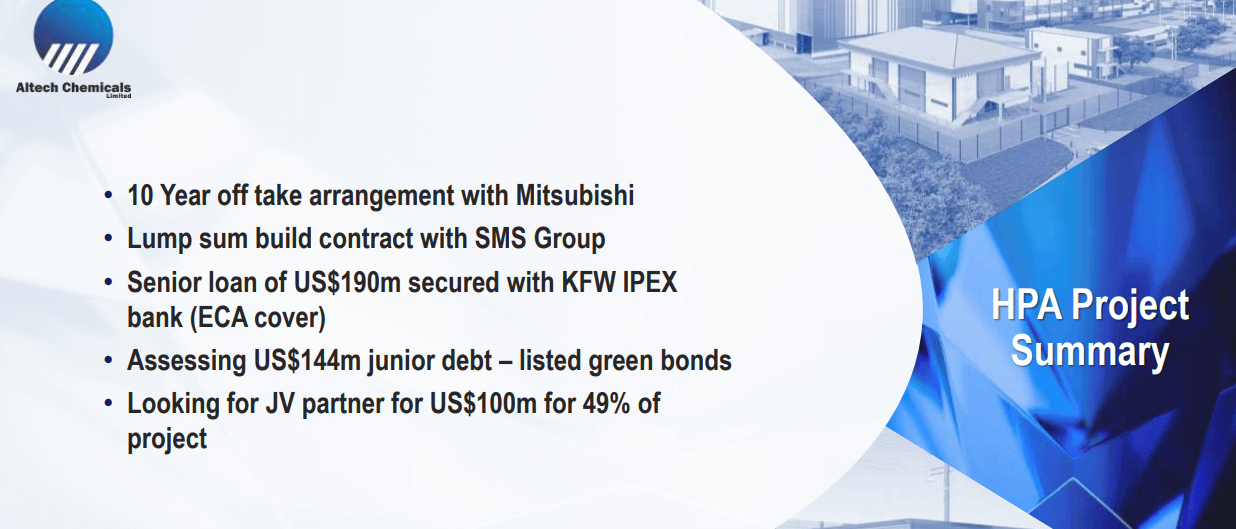
The High Purity Alumina Market
The HPA market currently stands at 30,000t per annum. The traditional manufacturing process does not utilise kaolin. Here, high-purity alumina is made by dissolving aluminium metal and hydrolyzing it.
Altech Chemicals develops alumina by the use of kaolin, which is a disruptive process. Kaolin is a considerably cheaper feedstock than aluminium metal. Kaolin is a mineral essentially owned by the company, as a result, the only overhead is the cost of extraction. This serves as feed for alumina for the HPA plant. The company’s production cost is nearly half or one-third compared to the competition. This has generated a lot of interest in the Johor HPA project.
The Johor plant is rated for producing around 4,500t of HPA on a yearly basis. This accounts for 15% of the market’s global supply.
The company has developed in-house technology to process kaolin. It has between 8-9 patents. These patents protect the company’s silumina anode technology and other intellectual properties. The company is focused on advancing its pilot plant. It is looking to sign a few off-take agreements with downstream partners. It is also working on a DFS study.
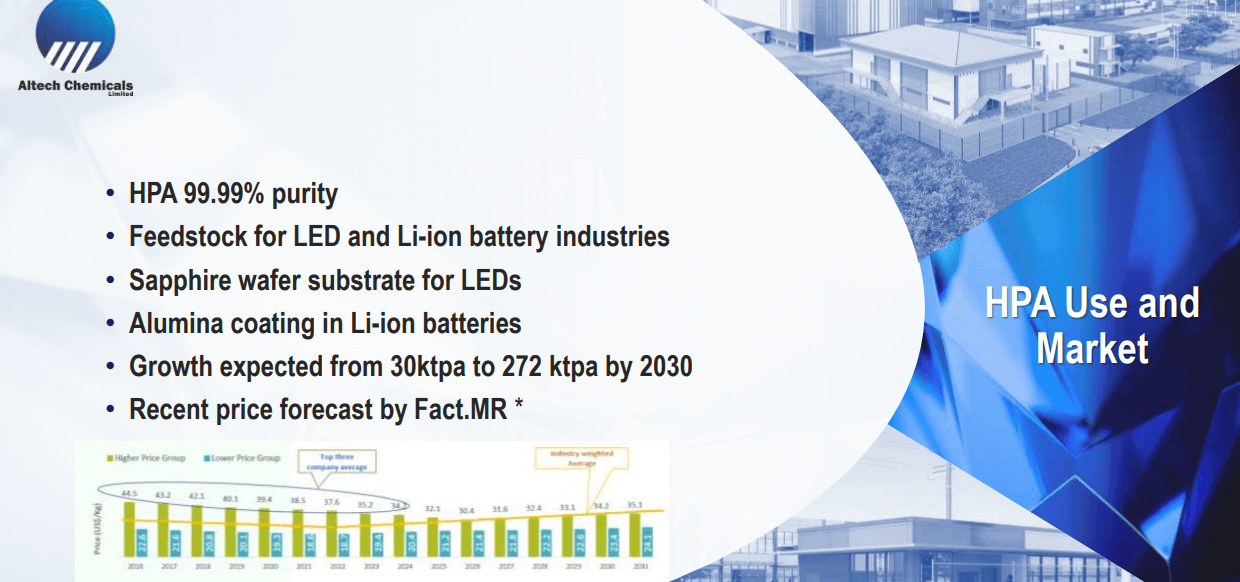
Cash Position
Altech Chemicals has a $120M current market cap. The capital cost investment for the Johor project is $400M along with an NPV (Net Present Value) estimated at $570M. The Silumina Anode project has a capital cost of $95M and a $507M NPV. The silumina anode project has significantly better economics compared to the HPA project.
To find out more, go to the Altech Chemicals website
Analyst's Notes




Subscribe to Our Channel
Stay Informed










